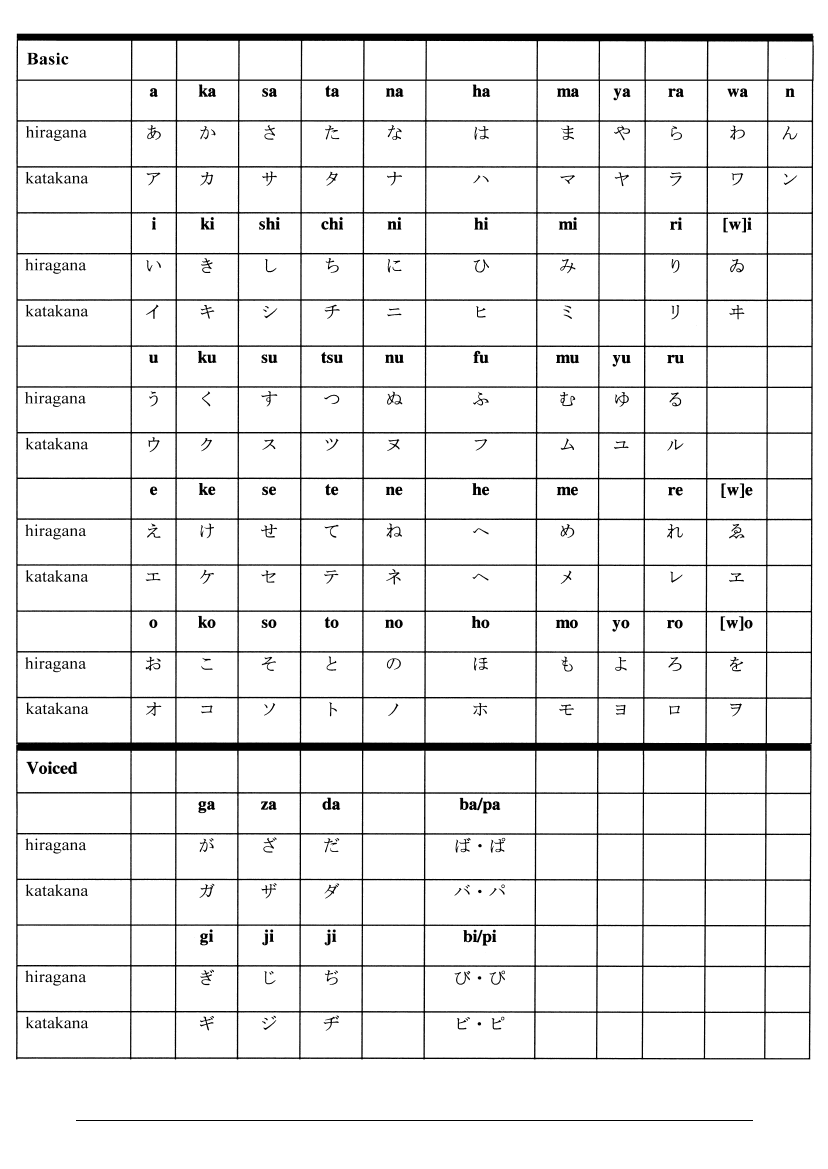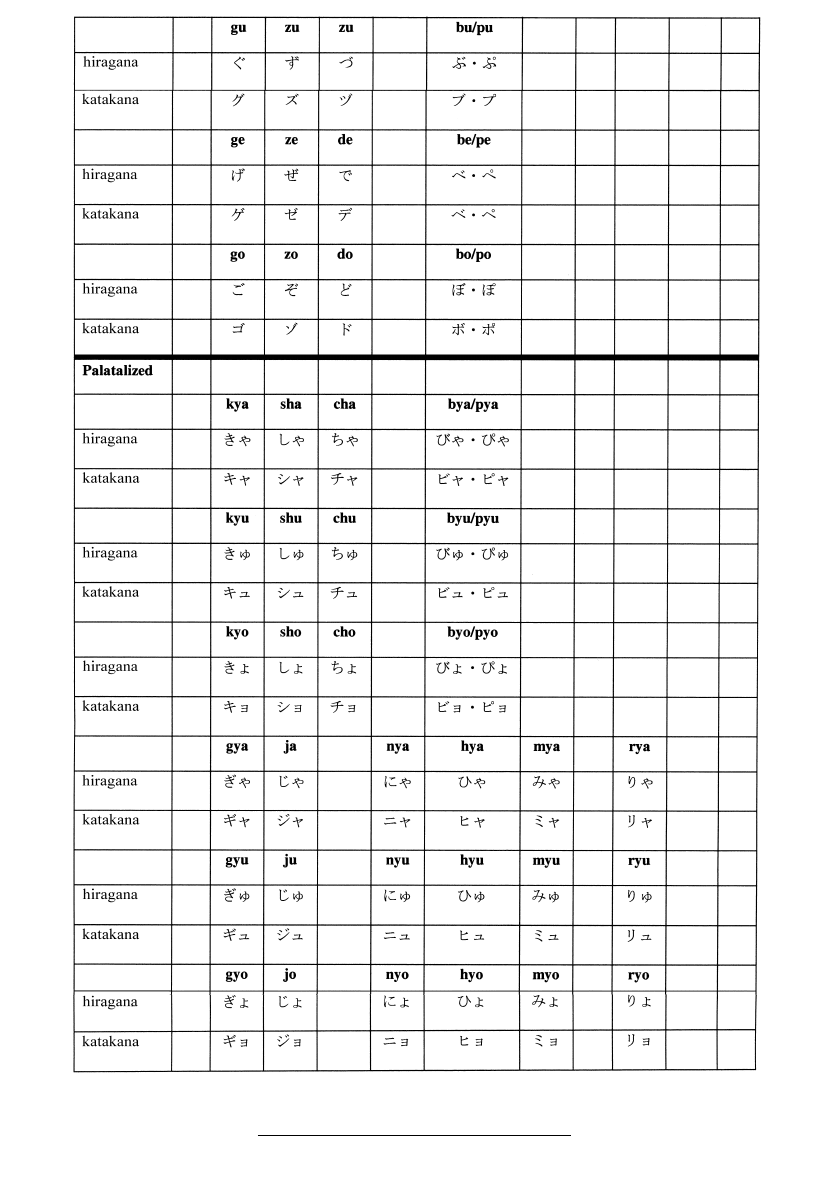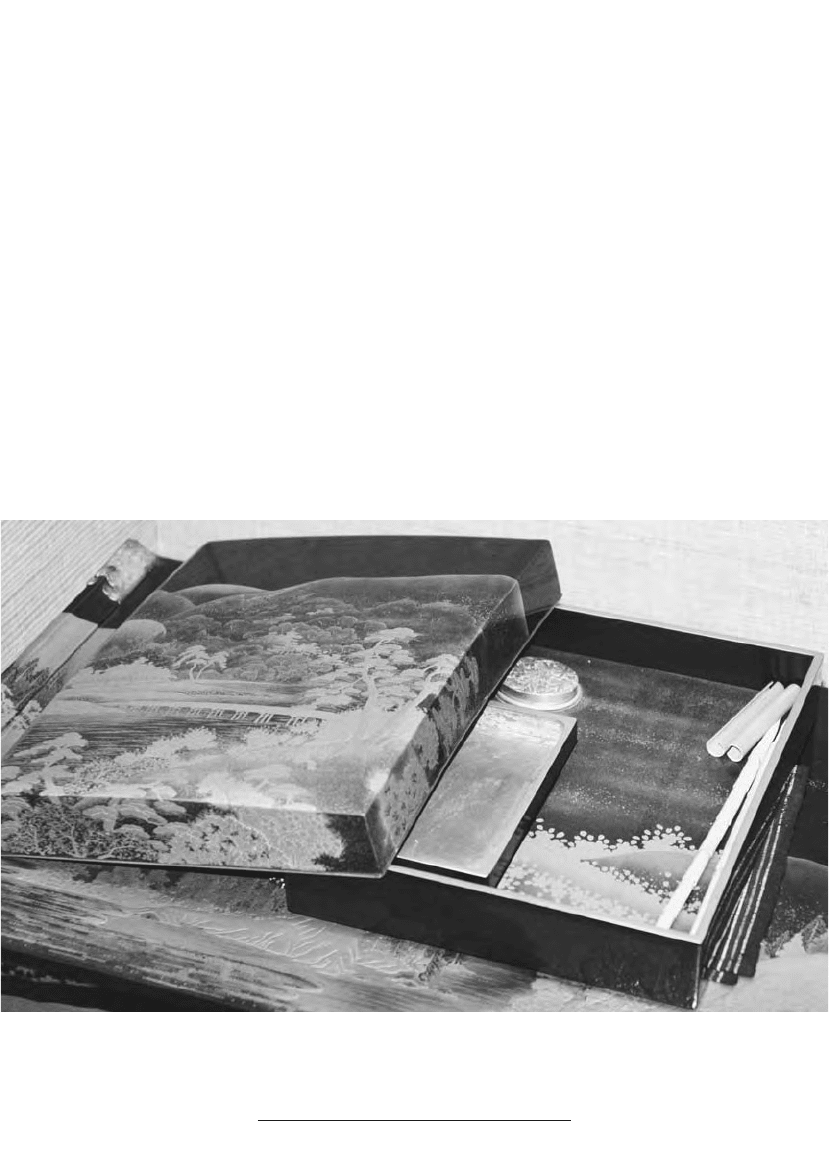Deal W.E. Handbook To Life In Medieval And Early Modern Japan
Подождите немного. Документ загружается.


H ANDBOOK TO L IFE IN M EDIEVAL AND E ARLY M ODERN J APAN
244
SYLLABIC SOUNDS IN THE JAPANESE LANGUAGE

L ANGUAGE AND L ITERATURE
245

Kanji Pronunciation: on and
kun Readings
Because of the hybrid nature of the Japanese written
language—combining aspects of both written Chi-
nese and spoken Japanese—its historical develop-
ment included two different ways of reading
Chinese characters (kanji). These two different
kinds of readings became known as the on reading
(on-yomi) and the kun reading (kun-yomi). The on
reading, also referred to as the Sino-Japanese read-
ing, is the Japanese approximation of the original
Chinese pronunciation. Chinese pronunciations
required modification to fit with the sounds of the
Japanese language. Some kanji have multiple on
readings. This is the result of the character importa-
tion process: characters came into use in Japan that
in China had different pronunciations depending on
historical period and region of the country. The kun
reading, also referred to as the Japanese reading, is a
native Japanese word that has the same meaning as
the character to which it is applied. Thus, for
instance, the kanji for country has an on reading of
koku. The Chinese pronounce this character guo—
the pronunciation koku is the Japanese modification
of the Chinese sound. The same country character
also has a kun reading of kuni. The word kuni is the
indigenous Japanese term for “country” that has
been applied to the reading of the kanji. Like on
readings, kun readings can be multiple for the same
character. Kun readings are a result of the assign-
ment of Japanese words with similar meanings to the
same character. For characters with multiple on
and/or kun readings, the choice of which pronuncia-
tion to use depends upon the linguistic context in
which the kanji is being used.
EXAMPLES OF ON AND KUN
READINGS FOR SOME COMMON
CHINESE CHARACTERS (KANJI)
Japanese Vocabulary
As a result of both indigenous and foreign influ-
ences on the development of the Japanese language,
there were three different kinds of vocabulary in
use in the medieval and early modern periods:
native Japanese words, Sino-Japanese words, and
foreign words (also referred to as “loan words”).
Sino-Japanese words were Japanese words of Chi-
nese origin, usually written as character com-
pounds, that is, two or more kanji written together
to form words. Sino-Japanese words are often used
to express abstract ideas. Some character com-
pounds are entirely Japanese in origin.
In Japanese, the notion of foreign words typi-
cally refers to lexical items borrowed from lan-
guages other than Chinese. Not surprisingly, the
Japanese borrowed the most words from cultures
with which they had the most contact. Often loan
words reflect borrowed aspects of material culture,
as well as the introduction of new concepts and spe-
cialized terminology. From Portuguese traders and
missionaries, for instance, the Japanese borrowed
such terms as pan (bread, from the Portuguese paõ)
and tempura (battered deep-fried vegetables and
fish, from the Portuguese tempero). After the Por-
tuguese were expelled from Japan in the first half of
the 17th century, Dutch influence predominated.
The Japanese borrowed words not only from
Dutch medical and scientific discourse, but also
such everyday words as biiru (beer, from the Dutch
bier).
H ANDBOOK TO L IFE IN M EDIEVAL AND E ARLY M ODERN J APAN
246

Writing Styles
The history of the varied Japanese writing styles is
complex as a result of the multiple ways of reading
and writing characters and kana. Texts from the
medieval and early modern periods reflected this
diversity of written forms. Some texts were written
in classical Chinese, others used Japanese generously
laced with kanji, while still others reflected a style
using mostly kana. Styles were also combined in
hybrid forms. The following brief list of written
styles is by no means exclusive, but it does reference
the most important.
CLASSICAL JAPANESE
Classical Japanese is a broad term that encompasses
writing in Japanese from the Heian period through
the Edo period. Classical Japanese is especially asso-
ciated with the literary style of Heian-period aristo-
crats. There are, in fact, a number of styles that fall
under this heading, including Japanese poetry that
uses little Chinese vocabulary, prose that uses mostly
Japanese diction, and writing that uses both Chinese
vocabulary and occasional applications of Chinese
syntax in otherwise Japanese sentences. From a con-
temporary perspective, any writing in Japanese prior
to about 1900 can be considered classical Japanese.
The Heian-period style of classical Japanese that
used little Chinese vocabulary was, by the start of
the medieval period, undergoing significant changes
as a result of interactions with Chinese. One result
of Chinese influence on Japanese was the develop-
ment of the Japanese-Chinese mixed style (wakan
konkobun) in the medieval period. This writing style
is treated below. In the Edo period, National Learn-
ing scholars (see chapter 7: Philosophy, Education,
and Science), in their attempt to reclaim a pristine
Japanese past cleansed of the taint of foreign influ-
ence, took a special interest in early Japanese poetry
and hence classical Japanese prior to the medieval
period.
L ANGUAGE AND L ITERATURE
247
8.1 Writing set, including brush and inkstone (Photo William E. Deal)

It is thought that the classical Japanese of Heian
aristocrats was closely connected to the spoken lan-
guage of the time. By the early modern period,
Japanese as spoken language bore little resemblance
to the spoken language of the Heian period. Hence,
classical Japanese came to be more and more
removed from colloquial speech. In the Edo period,
however, the colloquial speech of the day did find its
way into literature in which dialogue was central,
such as plays and some forms of fiction. Edo-period
vernacular literature, then, is also an aspect of classi-
cal Japanese, but a very different language than, say,
the classical Japanese of Heian poetry and prose.
CLASSICAL CHINESE
Classical Chinese (kambun; literally, “Chinese writ-
ing”) refers to any writings, particularly by Japanese,
composed in Chinese. In the medieval and early
modern periods, classical Chinese was especially
associated with and sometimes used in scholarly and
religious writing. It was also sometimes used as a lit-
erary language. Japanese poetry written in Chinese,
known as kanshi, is one example. The study of classi-
cal Chinese was also central to education in the early
modern period—students were expected to be able
to read and recite passages from the Chinese classics
both to promote literacy and to instill in children
fundamental Neo-Confucian values.
Difficulties in reading classical Chinese were
partly resolved through the Japanese use of a system
of marks that were placed within the Chinese text
and served as pointers on how to read and under-
stand the syntax of a particular Chinese passage.
While Japanese used a subject-object-verb word
order, Chinese used a subject-verb-object word
order. The use of these markings effectively showed
the reader how to render a Chinese sentence in clas-
sical Japanese.
VARIANT CHINESE
Variant Chinese (hentai kambun) refers to a hybrid
combination of both classical Chinese and classical
Japanese. The Japanese had learned to write Chi-
nese (kambun) during the centuries of contact with
the Asian mainland. After ongoing contact ended in
the late ninth century, Japanese writing in Chinese
more and more included such anomalies as Japanese
words, syntactical irregularities, and the misplace-
ment of verbs. While this variant or hybrid form of
classical Chinese might be perfectly understandable
to the Japanese, it would have been peculiar at best,
if not incomprehensible, to the Chinese. It was, in
effect, a writing style that looked Chinese but had
developed into a different language than classical
Chinese.
By the end of the Heian period, variant Chinese
was being used in government documents and in the
conduct of everyday business. In the medieval
period, variant Chinese was used to write a number
of different kinds of documents, including historical
narratives, shogunal records, contracts, and diaries
written by men. Variant Chinese was also used into
the Edo period.
JAPANESE-CHINESE MIXED STYLE
Japanese-Chinese mixed style (wakan konkobun) is,
strictly speaking, a form of classical Japanese. It is a
hybrid writing style that intermingles Japanese and
Chinese character readings, grammar, and lexical
items. Japanese-Chinese mixed style evolved out of
the practice of adding marks to Chinese texts in
order that they could be read more easily by Japan-
ese readers. This style developed in the medieval
period and was used into the Edo period. Classic
examples of compositions in this style are two
Kamakura-period texts, Heike monogatari (Tale of
the Heike) and Hojoki (An Account of My Hut).
EPISTOLARY STYLE
Epistolary style (sorobun) was a formal writing style
in use during the early modern period. As its name
suggests, this style was used for letters—both per-
sonal and official—and also in government-related
documents. The Tokugawa shogunate required that
all correspondence coming into its offices—such as
reports and requests—be written in this style. The
term sorobun derives from the frequent use of the
polite auxiliary verb soro that occurs in this writing
style. The use of this verb served to humble the
writer before the intended recipient—the govern-
ment. Like other Japanese writing styles, sorobun was
a hybrid form. Although it was based on classical
H ANDBOOK TO L IFE IN M EDIEVAL AND E ARLY M ODERN J APAN
248

Japanese, it used many Chinese characters, generally
left out kana used as particles and verb suffixes, and
often placed words in Chinese order.
LITERATURE
Introduction
Japanese literature has a long history dating back
to the early eighth century when the oldest extant
texts were compiled. Literature prior to the
medieval period had been almost entirely the work
of aristocrats. Texts like the Tale of Genji (Genji mono-
gatari, ca. 1000) are suffused with the sensibilities,
values, and aesthetics of Heian-period aristocrats.
While aristocratic literature retained its importance
throughout the medieval and early modern periods,
it was also supplanted in many ways by literature
that reflected the sensibilities of a much broader seg-
ment of Japanese society. Warriors, Buddhists, mer-
chants, masterless samurai, and geisha were among
those who became the subjects of this literature and
those whose interests this literature sometimes
expressed.
Medieval and early modern literature was written
in a variety of different styles, such as classical Japan-
ese, Japanese-Chinese Mixed Style, and Variant
Chinese. Literary sensibilities found expression in
such textual genres as poetry, fiction, drama, literary
theory, diaries, travel accounts, and journal-style
writings. Within these genres, there were many
different styles, such as the various kinds of poetry—
for instance, haiku and linked verse—and prose
writings—such as war tales and travel diaries.
The following discussion examines medieval and
early modern literature in historical perspective. It
should be noted that drama and other writing for
theater is not treated in this chapter for two reasons.
First, theater, including influential plays and play-
wrights, is treated in chapter 9: Performing Arts.
Second, the idea that plays were literature was
mostly a foreign idea in medieval and early modern
Japan. Plays were first and foremost an art to be per-
formed and observed. The texts of Kabuki plays
were not usually even published. Thus, to discuss
drama here might be in keeping with contemporary
sensibilities, but it would not reflect how theater was
consumed by the Japanese in the medieval and early
modern periods.
Medieval Literature
MEDIEVAL POETRY
Waka At the beginning of the medieval period,
waka poetry, so closely associated with Heian-period
aristocrats, was still a vibrant literary art. Waka
(“Japanese poem”), also referred to as tanka (“short
poem”), is verse that is composed of five lines with a
total of 31 syllables in a 5-7-5-7-7 pattern. Despite
the transformation of Japan into a country in which
warrior values were newly ascendant, poetry re-
mained a central mode of expression for aristocrats
and, often, well-educated Buddhist priests. This
is evidenced by the 15 imperial poetry anthologies
that were compiled during the medieval period. Fur-
ther, the poetry included in these anthologies fol-
lowed the poetic rules set down during the Heian
period.
Medieval waka did not express warrior values—it
was still very much an aristocratic art. But the tur-
moil of the Gempei War and the decline of the
political and social influence of the court was
reflected in the darker mood and tenor of some
medieval waka. The Buddhist notion of mappo, “the
end of the Dharma,” asserted that the world had
entered an era of spiritual darkness and confusion.
No doubt the period of civil war that ushered in the
medieval period contributed to the belief in the
veracity of this view. Buddhism also taught that life
is transient and that human fortunes are ephemeral.
This sense of the fundamental impermanence of
human existence was expressed by some aristocrats
and Buddhists through waka.
In the early Kamakura period, Fujiwara no Shun-
zei (or Toshinari, 1114–1204) and his son, Fujiwara
no Teika (or Sadaie; 1162–1241), were among the
most outstanding poets. Shunzei conceived of waka
composition as a spiritual practice analogous to
L ANGUAGE AND L ITERATURE
249

meditation. For him, composing waka was a way to
attain enlightenment if practiced with “concentra-
tion and insight” (shikan), a Tendai school form of
meditation. Both Shunzei and Teika set the aesthetic
tone for Kamakura-period waka. They promoted
the notion of “traditional language, fresh concep-
tions” (kotoba furuku, kokoro atarashi) in which the
language of traditional waka was used in new ways.
Innovative language, however, had to express the
aesthetic ideal of yugen, “mystery and depth,” that
was both a literary and spiritual goal aspiring to ele-
vate the prosaic into a profound beauty. They also
prized the use of honkadori, a technique whereby the
poet alludes to an earlier poem and then develops
this imagery in new ways.
These poetic ideals found expression in the
eighth imperial anthology, Shin kokinshu (New col-
lection of poems from ancient and modern times)
that was compiled by Teika and others around 1205.
The Shin kokinshu was commissioned by retired
Emperor Go-Toba whose poetry also appears in the
collection. Other prominent Shin kokinshu poets
include Teika, Shunzei, Fujiwara no Yoshitsune
(1169–1206), Princess Shokushi (d. 1201), Fujiwara
no Ietaka (1158–1237), and the Buddhist priests
Saigyo (1118–1190) and Jien (1155–1225). This col-
lection is widely regarded as containing the finest
waka of all medieval imperial poetry anthologies.
Renga Although waka continued to be written, by
the time the last imperially commissioned waka
anthology was compiled in 1439, the creativity of
this poetic form was already moribund. In part, waka
was a victim of its own poetic rules for how a poem
was to be composed, including the kinds of imagery
that were permissible. As a result, medieval poets
eschewed the rigidity of waka for the new poetic
possibilities of linked verse (renga). Between the
13th and 16th centuries, the best poets composed in
the renga style.
The structure of renga is similar to waka but the
poem created is the work of more than one poet
composing a sequence of consecutive verses. In
waka, one poet creates a 31-syllable verse of five
lines in a 5-7-5-7-7 syllable structure. In renga, a
poet composes the first three lines (5-7-5) and a sec-
ond poet composes the last two lines (7-7). By con-
tinuing this process, a long chain of alternating
5-7-5 and 7-7 lines is created. There was variability
in the number of lines that constituted a linked verse
sequence, but over time the standard length was set
at 100 stanzas.
Lines of verse are linked to each other through
associative word imagery and subject matter. For
instance, a poet might start with a verse about a
cuckoo, a bird that symbolizes summer. The next
poet might introduce the image of a pine tree which,
in Japan, has poetic associations to the cuckoo. The
Japanese word for pine (matsu) is also a homophone
for the verb “to wait,” a reference to waiting or
anticipating some event or action. The next poet,
expanding on the pine tree image, might create a
verse calling to mind a shady mountain scene with a
stream flowing through it. Pine trees are connected
to mountains, and both mountains and the heat of
summer are relieved by the mountain shade and the
cool flowing stream. A fourth poet might then intro-
duce the idea of a moonlit scene because other
Japanese imagery speaks of the Moon reflected in
H ANDBOOK TO L IFE IN M EDIEVAL AND E ARLY M ODERN J APAN
250
8.2 The late Heian–early Kamakura poet-priest Saigyo
(1118–90)
(Illustration Kikuchi Yosai from Zenken
kojitsu, mid-19th century)

water. The Moon symbolizes autumn; hence, this
linked sequence moves from summer to fall.
The idea of two poets composing a single waka
dates to the Heian period when the communal com-
position of a 31-syllable poem was a leisurely pas-
time. In the Heian practice, one poet composed the
first three lines and another poet the second
two lines, creating what is sometimes referred to
as a “short” renga. This practice was expanded in the
medieval period and much longer links were pro-
duced, the result of several poets working together.
By the 14th century, renga had become a serious
poetic style that eclipsed waka in importance. In
1356, Nijo Yoshimoto, a high-ranking Kyoto aristo-
crat, compiled the Tsukuba shu (Tsukuba Collection;
the title is a reference to a Manyo’shu poem), a
collection that secured for renga its status as a legiti-
mate literary art form. Yoshimoto’s successors fur-
ther advanced the reputation of renga. Of particular
note are the two renga masters, Shinkei (1407–75)
and Sogi (1421–1502).
Shinkei, a Buddhist priest, was not only a highly
regarded poet, but he also wrote theoretical treatises
on the nature of poetry in general and renga in par-
ticular. Not unlike Fujiwara no Shunzei’s view of
waka, Shinkei found a deep connection between
poetry composition and the religious quest for
enlightenment. For Shinkei, pursuit of poetic ideals
was deeply spiritual because it held the possibility of
profound expression about the nature of the world.
The aesthetic ideal of yugen (mystery and depth) was
central to the spiritual possibilities of poetry compo-
sition. Shinkei’s Sasamegoto (Whisperings, 1463) dis-
cusses his views of renga and its relationship to yugen
and other aesthetic ideals.
Sogi, also a Buddhist priest, was an accomplished
poet. He came from a commoner background, so his
poetry was informed not only by the refined sensi-
bilities of Kyoto poets but also by the lives of peas-
ants and farmers. Sogi exemplified the communal
nature of renga and the necessity of working closely
with other poets to create a coherent series of linked
verses. In 1488 Sogi traveled to Minase shrine, in a
village between Kyoto and Osaka, to compose a
renga sequence with two other renga masters,
Shohaku (1443–1527) and Socho (1448–1532). The
result of this collaboration was the 100-verse renga
composition titled Minase sangin hyakuin (One hun-
dred links by three poets at Minase), arguably the
finest example of the genre. The success of this text
stems from its ability to create a flow of associative
word imagery and subject matter.
MEDIEVAL PROSE
Diaries The medieval period continued the tradi-
tion of diary writing begun in the Heian period. As
in that period, many significant medieval diaries
were composed by aristocratic and Buddhist women.
The term diary is somewhat misleading, however,
because diaries were not necessarily daily or weekly
accounts written as events occurred. Rather they
were often memoirs, recollections, accounts of one’s
travels, or a combination of these, and many also
included poetry. To further complicate matters, the
term diary has also been applied to fictional stories
written in the form of diaries.
Travel diaries are sometimes treated as a separate
genre, but this is problematic because travel diaries
can include memories and recollections. There are
also different kinds of travel diaries, such as those
that recount pilgrimages to sacred places and
accounts of travel from Kyoto to the shogunate at
Kamakura to deal with legal matters. Diaries were
also written by poets about their journeys in the
countryside often to visit places associated with
famous poems of the past. Poetry is typically inter-
spersed with prose in such accounts. The famous
renga poets Sogi and Socho both wrote poetic travel
diaries in the Muromachi period.
Some representative medieval diaries include:
K
AIDOKI
(JOURNEY ALONG THE SEACOAST ROAD, 1223)
Written by an unknown man, this travel diary
recounts the author’s walking trip from Kyoto to
Kamakura visiting famous sites along the way.
K
ENREIMON’IN UKYO NO DAIBU NO SHU
(POETIC MEMOIRS OF LADY DAIBU, CA. 1231)
Kenreimon’in ukyo no daibu (ca. 1157–unknown),
or Lady Daibu, was an aristocratic woman who
served in the court of Emperor Go-Toba. Her mem-
oir is a particularly interesting glimpse at the life of
an aristocratic woman connected with the Taira
family—the vanquished clan of Gempei War fame—
L ANGUAGE AND L ITERATURE
251

whose lover, Taira Sukemori, was killed at the Battle
of Dannoura in the closing battle of the Gempei
War in 1185.
B
EN NO NAISHI NIKKI
(DIARY OF LADY BEN, CA. 1260)
Composed by the aristocratic woman Go-Fukakusa
In Ben no Naishi (dates unknown), who was in ser-
vice at the court of Emperor Go-Fukakusa, this
diary records events that occurred at court during
Go-Fukakusa’s reign.
I
ZAYOI NIKKI
(DIARY OF THE WANING MOON, 1280)
Composed by the Buddhist nun Abutsu (d. 1283),
this diary relates events connected with her journey
from Kyoto to Kamakura to press her claim about a
property dispute in the shogun’s courts.
T
OWAZUGATARI
(THE CONFESSIONS OF LADY NIJO, 1313)
This diary of Go-Fukakusa In no Nijo (1258–
unknown), an aristocratic woman who served in
the court of Emperor Go-Fukakusa, is commonly
known as The Confessions of Lady Nijo in English
translation. However, the literal meaning of the title
is “A Tale Nobody Asked For.” This diary recounts
Lady Nijo’s numerous love affairs and her eventual
dismissal from service to the court. She talks about
her decision to take the tonsure and become a Bud-
dhist nun. She then embarks on a number of jour-
neys that she describes in detail.
I
SE DAIJINGU SANKEIKI (ACCOUNT OF A
PILGRIMAGE TO THE GREAT SHRINE AT
ISE, 1342)
This travel diary by the Buddhist priest Saka Jubutsu
records his pilgrimage to the Shinto sacred site, the
Ise Shrine, in 1342. This diary is especially interest-
ing because of the view it provides of the relationship
between Buddhism and Shinto in the 14th century.
T
SUKUSHI MICHI NO KI (JOURNEY ALONG
THE
TSUKUSHI ROAD, 1480)
Sogi (1421–1502) was a noted renga poet and trav-
eler. His diary, Journey along the Tsukushi Road,
recounts his journey to Kyushu, visiting places of
historic and poetic significance along the way, and
interspersing poetry with his prose.
U
TSUNOYAMA NO KI
(ACCOUNT OF UTSUNOYAMA, 1517)
Like his friend Sogi, Socho (1148–1532) was a noted
renga poet and traveler. His diary, Account of
Utsunoyama, is both memoir and a recollection of
his travels to sites of historical and poetic interest.
Essays “Essay” refers to the genre known in Japan-
ese as zuihitsu (literally, “following the writing
brush”). These are miscellaneous essays or random
thoughts—often personal observations about people
and nature—set down with no particular structure in
mind. Two classic examples of this genre are also
among the most important literary works from the
Kamakura period: Hojoki (An Account of My Hut,
1212) by Kamo no Chomei (1155–1216) and Ts u-
rezuregusa (Essays in Idleness, ca. 1330) by Kenko
(Yoshida Kaneyoshi, ca. 1283–ca. 1352). The
authors were both Buddhist recluses, having left
behind a world in a state of social and political tur-
moil. For Kamo no Chomei, the unsettled time
period was the Gempei War (1180–85) and its after-
math; for Kenko, it was the political intrigue and
warfare that occurred at the transition from the
Kamakura and Muromachi periods.
Both of these works are imbued with the Bud-
dhist idea of impermanence (mujo), according to
which the world is a place of constant change and
instability. Both Kamo no Chomei and Kenko find
abundant evidence for the truth of this view in their
descriptions of the world they inhabit. They also
both raise questions about the nature of enlighten-
ment and its possibility in such a tumultuous world.
In the Hojoki, Chomei reveals his acute awareness of
impermanence and the transience of human exis-
tence. He also conveys his satisfaction at living a
simple, reclusive life. In the Tsurezuregusa, Kenko
reflects on the human condition and poignantly
recalls happier days now long past. Occasionally,
Kenko also assumes a moral tone in his reflections
on life and living.
War Tales War tales (gunki monogatari), composed
during the Kamakura and Muromachi periods,
became a very popular literary form. These tales
narrated stories of great conflicts and battles, and
described in detail the heroic victories and defeats of
the greatest warriors. Such stories also became the
H ANDBOOK TO L IFE IN M EDIEVAL AND E ARLY M ODERN J APAN
252

source for later literary and theatrical forms, includ-
ing the recitation of tales by itinerant biwa musicians
(biwa hoshi) and the dramatization of warrior exploits
in Kabuki and Bunraku dramas. War tales not only
reflected the interests of the ruling warrior class, but
they also framed a warrior ethic that, by the Edo
period, became codified as part of the way of the
warrior (bushido). Prized warrior values included
bravery, loyalty, duty to one’s lord, and a heroic
death. A list of some of the more important war tales
follows below. Special attention is given to the Heike
monogatari (Tale of the Heike), widely regarded as the
classic and best example of this literary genre.
Some representative medieval war tales include:
H
OGEN MONOGATARI (TALE OF THE HOGEN
DISTURBANCE, CA. EARLY 13TH CENTURY)
The Hogen monogatari recounts the events and
armed conflict that occurred in 1156 when the
retired emperor Sutoku made an unsuccessful
attempt to gain control of imperial power against
the current emperor, Go-Shirakawa.
H
EIJI MONOGATARI (TALE OF THE HEIJI
DISTURBANCE, CA. EARLY 13TH CENTURY)
The Heiji monogatari recounts the events and armed
conflict that occurred in 1156–60, in Fujiwara
Nobuyori’s failed attempt to seize power from the
Taira family.
H
EIKE MONOGATARI (TALE OF THE HEIKE,
FIRST HALF OF THE 13TH CENTURY)
The Heike monogatari recounts the political intrigue,
battles, heroics, and other events that occurred
before, during, and after the Gempei War (1180–85)
between the Taira (or Heike) and Minamoto (or
Genji) warrior families (see chapter 1: Historical
Context, for details on the Gempei War). The Heike
story focuses on the ascent of the Taira warrior clan to
power in the waning years of the Heian period, their
control of the imperial court, and their eventual fall
and defeat at the hands of forces led by the Minamoto
clan. Many classic Japanese stories of bravery, loyalty,
self-sacrifice, and honor in defeat derive from the
Heike monogatari. It is arguably the most important of
all the war tales, and certainly the one that gave defin-
itive shape to the war tale genre. This tale became
widely known across all social classes by virtue of the
many literary and theatrical genres used to narrate the
Heike monogatari’s stories. Notable among these were
the oral recitations of the Heike story by itinerant
biwa players during the medieval period.
There are two important Buddhist themes that
set the tone for the entire work: impermanence and
karmic retribution. The famous opening lines of the
Heike remark on the impermanence (mujo) of the
world and the fleeting nature of human existence, a
sensibility repeated throughout the text. The notion
that all things necessarily perish foreshadows the
inevitable downfall of the Taira family from power.
The cause of their fall is not fated, but is rather a
direct result of karmic retribution, that is, retribu-
tion for evil actions. The Buddhist view is that all
actions, good and bad, have a positive or negative
consequence. The arrogance and ruthlessness of the
Taira result in a downfall that is both deserved and
inescapable.
A sensibility expressed in the Heike monogatari
that tends to run counter to Western values is the fo-
cus on the defeated rather than the victorious. There
is a strong sense of tragedy and sadness that pervades
the Heike’s account of the Tairas’ downfall. Sympa-
thy for the defeated, fueled in part by the Buddhist
virtue of compassion, tempers any negative evalua-
tions of the Taira.
One interesting theory concerning the early
development of the Heike monogatari asserts that
there may have been a ritual aspect to the early oral
recitations of the events that later became the Heike
text. There existed in Japan a tradition of chanting
Buddhist texts as a way to pacify the souls of the
dead that might otherwise wreak havoc on the liv-
ing. The chanting of the Heike text may have been
intended to pacify the souls of those who had died in
the Gempei War.
G
EMPEI SEISUIKI (AN ACCOUNT OF
THE
GEMPEI WAR, EARLY 14TH CENTURY)
The Gempei seisuiki (or josuiki), like the Heike mono-
gatari, recounts the battles, heroics, and other events
that occurred before and during the Gempei War
(1180–85) between the Taira (or Heike) and
Minamoto (or Genji) warrior families. Unlike the
Heike monogatari, which developed originally out of
an oral storytelling tradition, the Gempei seisuiki
developed from the first as a written narrative.
L ANGUAGE AND L ITERATURE
253
